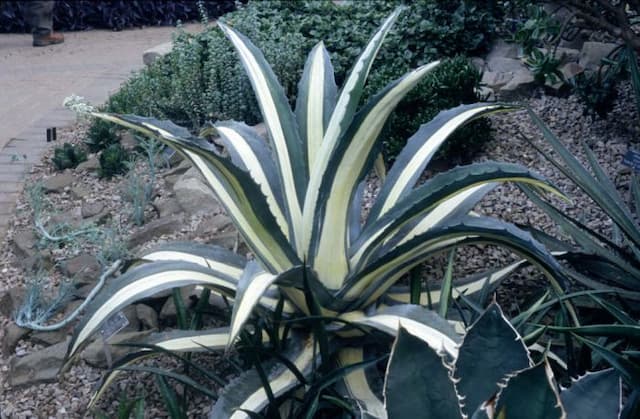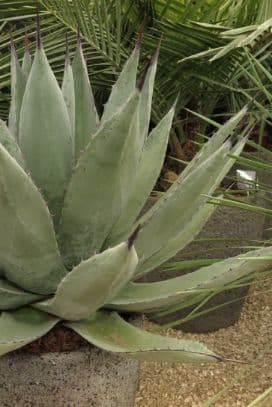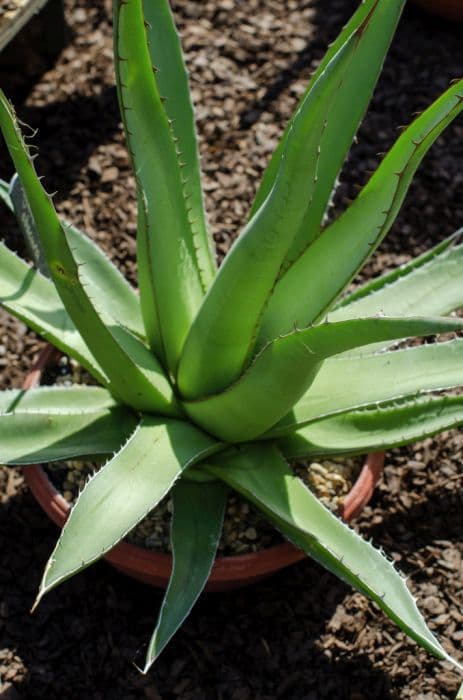Octopus Plant Eucomis vandermerwei 'Octopus'

ABOUT
The Eucomis vandermerwei 'Octopus', commonly known as the Pineapple Lily, is a distinctive and attractive plant characterized by its unique flower spike and rosette of strappy leaves. The leaves of this variety are deep green with a purplish underside, often spotted or mottled with maroon, which gives them a striking appearance. This particular cultivar boasts a central flower spike that strongly resembles a pineapple due to its topknot of leafy bracts. These bracts are also tinted with maroon, complementing the leaves. The flowers themselves are small, star-shaped, and densely packed around the spike, which may range in color from greenish to deep purple, with a distinctive burgundy hue at the edges. The overall impression is one of an exotic, tropical bloom despite the plant's actual origins. The intriguing 'Octopus' name within this cultivar's title suggests the ability of the leaves and flower spike to evoke the limbs of an octopus, adding to its whimsical charm.
About this plant
 Names
NamesFamily
Asparagaceae
Synonyms
Octopus Eucomis, Octopus Pineapple Lily
Common names
Eucomis vandermerwei 'Octopus'.
 Toxicity
ToxicityTo humans
Pineapple Lily (Eucomis vandermerwei 'Octopus') is not widely known to be highly toxic to humans. However, as with many plants, it may cause mild irritation or an allergic reaction in some individuals if ingested or if the sap comes into contact with skin or mucous membranes. If ingested, symptoms could include gastrointestinal discomfort, such as nausea, vomiting, diarrhea, or abdominal pain. It is always advisable to exercise caution and keep plants out of reach of children, who might be tempted to ingest plant parts out of curiosity.
To pets
Pineapple Lily (Eucomis vandermerwei 'Octopus') may not be extensively documented for toxicity to pets, such as dogs and cats. However, pets may have adverse reactions to ingesting plants not typically within their diet. In general, ingestion may cause mild gastrointestinal upset, resulting in symptoms like drooling, vomiting, or diarrhea. If a pet consumes a part of this plant and displays concerning symptoms, it is recommended to consult a veterinarian. Out of an abundance of caution, it is prudent to keep such plants away from pets.
 Characteristics
CharacteristicsLife cycle
Perennials
Foliage type
Deciduous
Color of leaves
Green
Flower color
Purple
Height
6-8 inches (15-20 cm)
Spread
6-8 inches (15-20 cm)
Plant type
Bulb
Hardiness zones
7
Native area
South Africa
Benefits
 General Benefits
General Benefits- Aesthetic Appeal: Adds a unique visual interest to gardens with its striking octopus-like flowers and spotted foliage.
- Drought Tolerance: Once established, it is quite drought-resistant, making it an ideal plant for drier climates and water-wise gardens.
- Easy Maintenance: Requires minimal care beyond occasional watering and feeding, making it suitable for busy or novice gardeners.
- Attracts Pollinators: Flowers produce nectar that attracts bees, butterflies, and other beneficial pollinators to the garden.
- Unique Flowering: The plant produces unusual flower spikes that add an exotic touch to both gardens and floral arrangements.
- Container Gardening: Well-suited for pots and containers, allowing for cultivation in small spaces like patios and balconies.
- Deer Resistance: Often resistant to browsing by deer, which makes it suitable for gardens in areas with deer populations.
- Long Blooming: Offers a long blooming season, which provides extended interest in the garden or in cut flower displays.
- Compact Size: Its relatively small size makes it easy to fit into different garden designs without dominating the space.
 Medical Properties
Medical PropertiesThis plant is not used for medical purposes.
 Air-purifying Qualities
Air-purifying QualitiesThis plant is not specifically known for air purifying qualities.
 Other Uses
Other Uses- The common name of Eucomis vandermerwei 'Octopus' is Pineapple lily. Pineapple lily extract can be used in perfumery to give a fragrant, exotic scent to various products.
- Pineapple lily's robust and unusual flower spikes can be used in floral arrangements, especially those requiring an exotic or tropical theme.
- The dried seed heads of Pineapple lily can be painted and used in decorative crafts for their unique, star-like appearance.
- The leaves of Pineapple lily can serve as a natural mulch, decomposing to enrich the soil with organic matter.
- Pineapple lily flowers, with their dense clusters, can be used to create dramatic centerpieces for tables and events.
- As a teaching tool in botany and horticulture, Pineapple lily serves as a prime example of a bulbous monocotyledonous plant with unique floral structures.
- Photographers and artists may use the striking appearance of Pineapple lily as a subject for artwork, such as botanical illustrations or photographic collections.
- In ecological gardens, Pineapple lily can be grown to support biodiversity, by providing nectar to pollinators like bees and butterflies.
- The robust nature of Pineapple lily makes it a candidate for xeriscaping, contributing to water-conserving gardening practices.
- Pineapple lily can be included in educational gardens to showcase South African flora and the importance of preserving native plants.
Interesting Facts
 Feng Shui
Feng ShuiThe Pineapple Lily is not used in Feng Shui practice.
 Zodiac Sign Compitability
Zodiac Sign CompitabilityThe Pineapple Lily is not used in astrology practice.
 Plant Symbolism
Plant Symbolism- Rarity: Eucomis vandermerwei 'Octopus', commonly known as 'Octopus' Pineapple Lily, is a rare species, symbolizing uniqueness and value in its scarcity.
- Strangeness: With its unusual shape resembling an octopus or the top of a pineapple, it can symbolize the beauty found in the strange and uncommon.
- Exotic allure: Native to South Africa, this plant brings an exotic charm that can be associated with mystery and discovery.
- Curiosity: The plant's peculiar appearance ignites curiosity and symbolizes the joy of new experiences and exploration.
- Survival: As it thrives in rocky grasslands, the Pineapple Lily represents resilience and the ability to thrive despite challenging conditions.
 Water
WaterFor the Octopus plant (Eucomis vandermerwei 'Octopus'), it's important to maintain a consistent watering schedule during its growing season in spring and summer, allowing the soil to dry slightly between waterings. Water the plant deeply once a week with approximately 16 to 24 ounces of water, depending on the size of the pot and the environmental conditions. In fall and winter, reduce the frequency of watering as the plant enters dormancy. It's crucial to avoid waterlogging, so ensure that the pot has proper drainage to prevent root rot.
 Light
LightThe Octopus plant thrives in bright, indirect light, making it an ideal candidate for a spot near a window with filtered sunlight or a patio that receives dappled shade. Direct sunlight can scorch the leaves, so it's best to position the plant where it will receive soft light throughout the day. If kept indoors, rotating the plant occasionally will ensure even growth by exposing all sides to light.
 Temperature
TemperatureThe Octopus plant prefers warm temperatures, with ideal conditions ranging between 60°F and 75°F. It should not be exposed to temperatures below 50°F, as cold drafts can be detrimental. This tropical bulb can tolerate higher temperatures as long as it's not in direct sun and has adequate moisture. It can survive short periods above 75°F, but prolonged heat can stress the plant.
 Pruning
PruningPruning of the Octopus plant is generally done to remove spent flower spikes and yellowing leaves to encourage new growth and maintain a tidy appearance. After the flowering period in late summer or early fall, prune the flower stalks close to the base. Occasional removal of old leaves is best done in spring or as needed. Regular pruning helps to direct the plant's energy to new, healthy growth.
 Cleaning
CleaningAs needed
 Soil
SoilThe Octopus plant prefers a well-draining soil mix consisting of two parts loam, one part sand or perlite, and one part compost to ensure proper drainage and fertility. The ideal soil pH for this plant should be slightly acidic to neutral, between 6.0 and 7.0.
 Repotting
RepottingOctopus plants should be repotted every two to three years or when the bulb has outgrown its pot to ensure adequate room for growth and to refresh the soil.
 Humidity & Misting
Humidity & MistingOctopus plants thrive best in moderate humidity levels; aim for a humidity range of 40-60% to maintain optimal health and growth for this plant.
 Suitable locations
Suitable locationsIndoor
Place in bright, indirect light and ensure good air circulation for Octopus plants indoors.
Outdoor
Plant in part shade and protect from strong winds for outdoor cultivation of Octopus plants.
Hardiness zone
7-10 USDA
 Life cycle
Life cycleEucomis vandermerwei 'Octopus', commonly known as Octopus Plant, begins its life cycle as a bulb, which, when conditions are favorable, sends up a rosette of strap-shaped leaves. The growth phase progresses as the plant develops a central flower spike, which is adorned with star-shaped flowers arranged in a raceme, resembling an octopus’ tentacles. After pollination, typically by insects, the flowers are followed by seed capsules that, once mature, split open to release seeds. The plant then goes through a period of dormancy, where the leaves die back, and the bulb remains underground, conserving energy. During this dormant phase, especially in colder climates, it is necessary to protect the bulb from freezing. With the arrival of the next growing season, the cycle repeats as the bulb produces new leaves and begins the process anew.
 Propogation
PropogationPropogation time
Summer
The most popular method of propagation for Eucomis vandermerwei 'Octopus', also known as Octopus Plant, is through the division of offsets. These are small bulbs that form around the base of the mature plant. The best time to divide the Octopus Plant is after the foliage has died back, usually in late summer or early fall. To propagate, carefully unearth the parent bulb and gently separate the offsets from the main plant. Each offset should have some roots attached. Plant the offsets at a depth of about 3 inches (approximately 7.6 centimeters) in well-draining soil, and water them well. They should be spaced about 8 inches (20 centimeters) apart to allow for growth. With proper care, these will grow into new plants over the coming seasons.









